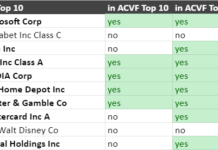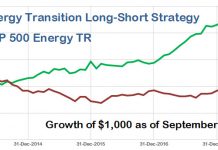When I was researching my Comparison of Clean Energy Mutual Funds and Clean Energy Tracking Portfolio articles, I came across something strange: the American Trust Energy Alternatives Fund (ATEAX) did not seem to have a listing on American Trust’s website. However, finance sites were still publishing price and holdings data, and there was no recent news, so I didn’t think much of it, since other funds seemed superior based on both costs and fund holdings.
Last week, I noticed that the fund’s price had not changed since the end of February, so I did a little digging. Here is what I found:
- The fund’s website, from this August 2008 article, is down.
- The fund manager, Carey Callaghan, has not done any interviews in that capacity since 2008, although he seemed to be doing one or two a month before then.
- A cached page on Google from Fidelity (which distributed the fund) stated that it was "closed to all investors." The original page no longer exists.
It’s not particularly surprising that the fund closed. It was launched in July 2008, shortly before the financial crisis began. A mutual fund needs to acquire significant assets in order to pay for its costs out of management fees, and even distribution by Fidelity was not enough to help a new fund acquire assets in the last half of 2008.
Since the fund only had a few million dollars under management, it’s not particularly surprising that its disappearance made no ripple.
Updates
The exponential growth in the number of available clean energy funds I talked about in the intro to my Costs of Green Funds article has broken down:

Also, since ATEAX is defunct, I will be comparing my Clean Energy Tracking Portfolio to only the remaining five funds. As of the close on March 13th, the five stock portfolio is up 5.6% (including commissions), compared to the remaining 5 funds, which have fallen 0.9% (after front-end load), with a range of -1.2% to +1.7%. Although it is still early days, my tracking portfolio is clearly tracking the funds very poorly. When it comes to tracking portfolios, a significant out performance is just as bad as a significant underperformance, because it brings into question the procedure used to form the tracking portfolio.
If I were to revise my procedure to come up with a better tracking portfolio I would:
- Look at the top 10 holdings of the remaining funds, not just the top 5.
- Try to match the allocation to various clean energy sectors that the funds were using.
Efficiency and Smart Grid Outperform
Because I decided to use one equally-weighted stock in each sector, I was relatively underexposed to solar and wind compared to the funds, and over-exposed to Efficiency and Electric Grid stocks. The difference in sector allocation probably accounts for much of my tracking portfolio’s out performance over the last couple weeks. As I discussed in my article about the American Recovery and Reinvestment Act, as well as in my repeated emphasis on the sectors over the last two years, these sectors have always been likely to outperform.
If I expected Energy Efficiency and Grid stocks to outperform, why do the clean energy funds have such a heavy emphasis on Solar and Wind Stocks? It’s probably not because I’m smarter than they are. More likely, it’s because, if you don’t want your mutual fund to fold like the unfortunate American Trust, you need to sell your fund to investors. And investors get excited about wind and solar… they get much less excited about energy efficiency.
When I last asked readers what stocks I should research, I got one request for a combination electric grid and wind stock (which I had covered previously,) no requests for efficiency stocks, four requests for Solar, and two requests for pure wind stocks. With demand like that, I could probably increase my readership if I spent more time talking about solar, and the mutual funds are simply doing what’s in their best interest: they buy solar and wind so that their investors will buy the funds.
Mutual funds are giving investors what they want. If that means buying trendy sectors, then trendy sectors are what the funds buy.
Tom Konrad, Ph.D.
DISCLAIMER: The information and trades provided here are for informational purposes only and are not a solicitation to buy or sell any of these securities. Investing involves substantial risk and you should evaluate your own risk levels before you make any investment. Past results are not an indication of future performance. Please take the time to read the full disclaimer here.









I for one would love to see more research into energy efficiency — particularly the companies that produce the hardware (like light switches and insulation) that go into efficiency increases. I know a little bit about the industry, but it would be great to hear your take!
Another question I’d love answered is what’s going on with Telvent (TLVT)? This is a company trading at less than 6x next year’s earnings that offers one of the most complete portfolios of smart grid technology that I’ve come across so far. The only other company that arguably offers coverage as broad as theirs is Comverge, and oh look! Telvent actually makes money! However, it appears that a grand total of 100 shares of TLVT changed hands yesterday. What’s going on with that?
Perhaps a quick note on survivorship bias in index construction, eh?
Coby…
I have no idea why Telvent gets so little attention… probably because it has much more significat operations in Europe than the US… combine that with a funny name, and it does not require much to make the stock fall… just like what happened with Portec a couple weeks ago.
Thanks for the vote of confidence on my interest in EE. I have a few companies in the arena I’m thinking of profiling.
Climateer- good point.
Survivorship bias is the tendency of indecies to be biased upwards over time as poor performers close their doors. Fortunately, in this case, it does not seem that ATEAX failed because of poor performance while it was operating… the worst performing funds over that period were the Calvert, Guinness Atkinson, and Winslow green growth fund. ATEAX was #3, but very close to the two leaders over the period in actual performance.